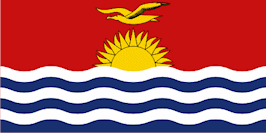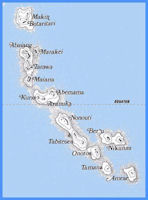Kiribati
 Kiribati (pronounced "keer-ah-bhass") consists of 32 low-lying atolls and one raised island scattered over an expanse of ocean equivalent in size to the continental United States. Britain offered Kiribati an army; founding President Iremia Tabai said no thanks.
Kiribati (pronounced "keer-ah-bhass") consists of 32 low-lying atolls and one raised island scattered over an expanse of ocean equivalent in size to the continental United States. Britain offered Kiribati an army; founding President Iremia Tabai said no thanks.
Kiribati, geographically huge but dramatically under-resourced, straddling the equator for 3000 miles with a total population of 100,000, cannot sustain itself. By 2008 President Tong was already talking with New Zealand about finding a new homeland for his people when atolls become inundated. Kiribati was the scene of a strange power struggle between China and Taiwan.
The islands, with a population (2011 est.) of 102,697, straddle the Equator and lie roughly halfway between Hawaii and Australia. The three main groupings are the Gilbert Islands, Phoenix Islands, and Line Islands. In 1995 Kiribati unilaterally moved its date line to include its easternmost islands, putting the country in the same date and time zone.
Kiribati includes Kiritimati (Christmas Island), the largest coral atoll in the world, and Banaba (Ocean Island), one of the three great phosphate islands in the Pacific. Except on Banaba, very little land is more than three meters above sea level.
This republic may rightfully be called "the most oceanic state" in Oceania — one of the largest collection of islands in the world, scattered over the huge expance of the planet's largest ocean. The 33 atolls which comprise Kiribati extend from west to east for almost 4,000 kilometers, and from north to south — for over 2,000. Yet their total area comprises only 823 square kilometers. As most of the other countries in the South Pacific region, Kiribati is among the smallest states in the world.
The Republic of Kiribati is located on an archipelago formed by three groups of coral islands: Gilbert, Line and Phoenix. Its name comes from the toponym adopted for the most populated group of islands by the Russian scientist and traveller, the honored academician I. F. Kruzenshtern in the 20's of the last century. Kiribati is the closest variant of the word "Gilbert" in the pronunciation of the local micronesian dialect. (T. Gilbert was one of the English researchers studying the archipelago).
The largest in population is Tarawa atoll (18,000 residents). The capital, Bairiki, is located here. The largest in size is Kiritimati atoll (364 square kilometers. Its former name was Christmas Island (Kirimati — the Micronesian variant of pronunciation for the English word "Christmas"). The state is still very young. Its independence was declared on 12 July 1979. Prior to 1975 it had been the British colony of Gilbert and Ellis Islands, and from 1975 through 1979, after the residents of the Ellis Islands — Polynesians - expressed the desire to create their own political formation (the state of Tuvalu), it was called Gilbert Island. The area of the populated islands is 719 square kilometers.
The original inhabitants of Kiribati are Gilbertese, a Micronesian people. Approximately 90% of the population of Kiribati lives on the atolls of the Gilbert Islands. Although the Line Islands are about 2,000 miles east of the Gilbert Islands, most inhabitants of the Line Islands are also Gilbertese. Owing to severe overcrowding in the capital on South Tarawa, in the 1990s a program of directed migration moved nearly 5,000 inhabitants to outlying atolls, mainly in the Line Islands. The Phoenix Islands have never had any significant permanent population. A British effort to settle Gilbertese there in the 1930s lasted until the 1960s when it was determined the inhabitants could not be self-sustaining.


|
NEWSLETTER
|
| Join the GlobalSecurity.org mailing list |
|
|
|


